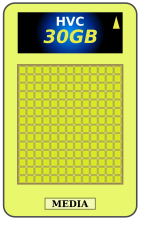
Computer data storage is a technology consisting of computer components and recording media that are used to retain digital data. It is a core function and fundamental component of computers.

In computing and optical disc recording technologies, an optical disc (OD) is a flat, usually circular disc that encodes binary data (bits) in the form of pits and lands on a special material, often aluminum, on one of its flat surfaces. Its main uses are physical offline data distribution and long-term archival. Changes from pit to land or from land to pit correspond to a binary value of 1; while no change, regardless of whether in a land or a pit area, corresponds to a binary value of 0.

Video CD is a home video format and the first format for distributing films on standard 120 mm (4.7 in) optical discs. The format was widely adopted in Southeast Asia, Central Asia and the Middle East, superseding the VHS and Betamax systems in the regions until DVD-Video finally became affordable in the first decade of the 21st century.

MiniDisc (MD) is an erasable magneto-optical disc-based data storage format offering a capacity of 60, 74, and later, 80 minutes of digitized audio.

The LaserDisc (LD) is a home video format and the first commercial optical disc storage medium, initially licensed, sold and marketed as MCA DiscoVision in the United States in 1978. Its diameter typically spans 30 cm (12 in). Unlike most optical disc standards, LaserDisc is not fully digital and instead requires the use of analog video signals.

The enhanced versatile disc (EVD) is an optical-medium-based digital audio/video format, developed by Beijing E-World, as a rival to the DVD to avoid the high royalty costs associated with the DVD format. Its development was supported by the Chinese government. While it was intended to replace the DVD standard in China by 2008, the format had failed to gain traction and ultimately faded into obsolescence.

A USB flash drive is a data storage device that includes flash memory with an integrated USB interface. It is typically removable, rewritable and much smaller than an optical disc. Most weigh less than 30 g (1 oz). Since first appearing on the market in late 2000, as with virtually all other computer memory devices, storage capacities have risen while prices have dropped. As of March 2016, flash drives with anywhere from 8 to 256 gigabytes (GB) were frequently sold, while 512 GB and 1 terabyte (TB) units were less frequent. As of 2018, 2 TB flash drives were the largest available in terms of storage capacity. Some allow up to 100,000 write/erase cycles, depending on the exact type of memory chip used, and are thought to physically last between 10 and 100 years under normal circumstances.

Versatile Multilayer Disc was a high-capacity red-laser optical disc technology designed by New Medium Enterprises, Inc. VMD was intended to compete with the blue-laser Blu-ray Disc and HD DVD formats and had an initial capacity of up to 30GB per side. At a physical level, VMD is identical to DVD, but with the possibility of using more layers.

The Holographic Versatile Disc (HVD) is an optical disc technology that was expected to store up to several terabytes of data on an optical disc 10 cm or 12 cm in diameter. Its development commenced in April 2004, but it never arrived due to lack of funding. The company responsible for HVD went bankrupt in 2010.
In computing, external storage comprises devices that store information outside a computer. Such devices may be permanently attached to the computer, may be removable or may use removable media.

DataPlay is an optical disc system developed by DataPlay Inc. and released to the consumer market in 2002. Using very small disks enclosed in a protective cartridge storing 250MB per side, DataPlay was intended primarily for portable music playback, although it could also store other types of data, using both pre-recorded disks and user-recorded disks. It would also allow for multisession recording. It won the CES Best of Show award in 2001.

Holographic data storage is a potential technology in the area of high-capacity data storage. While magnetic and optical data storage devices rely on individual bits being stored as distinct magnetic or optical changes on the surface of the recording medium, holographic data storage records information throughout the volume of the medium and is capable of recording multiple images in the same area utilizing light at different angles.

This article compares the technical specifications of multiple high-definition formats, including HD DVD and Blu-ray Disc; two mutually incompatible, high-definition optical disc formats that, beginning in 2006, attempted to improve upon and eventually replace the DVD standard. The two formats remained in a format war until February 19, 2008, when Toshiba, HD DVD's creator, announced plans to cease development, manufacturing and marketing of HD DVD players and recorders.

The Stacked Volumetric Optical Disc is an optical disc format developed by Hitachi Maxell, which uses an array of wafer-thin optical discs to allow data storage.

The DVD is a digital optical disc data storage format invented and developed in 1995 and released in late 1996. Currently allowing up to 17.08 GB of storage, the medium can store any kind of digital data and was widely used for software and other computer files as well as video programs watched using DVD players. DVDs offer higher storage capacity than compact discs while having the same dimensions.

The Blu-ray Disc (BD), often known simply as Blu-ray, is a digital optical disc storage format. It is designed to supersede the DVD format, and capable of storing several hours of high-definition video. The main application of Blu-ray is as a medium for video material such as feature films and for the physical distribution of video games for the PlayStation 3, PlayStation 4, PlayStation 5, Xbox One, and Xbox Series X. The name "Blu-ray" refers to the blue laser used to read the disc, which allows information to be stored at a greater density than is possible with the longer-wavelength red laser used for DVDs.

HD DVD is a discontinued high-density optical disc format for storing data and playback of high-definition video. Supported principally by Toshiba, HD DVD was envisioned to be the successor to the standard DVD format.
As of 2021, multiple consumer-oriented, optical-disk media formats are or were available:

Although research into optical data storage has been ongoing for many decades, the first popular system was the Compact Disc, introduced in 1982, adapted from audio (CD-DA) to data storage with the 1985 Yellow Book, and re-adapted as the first mass market optical storage medium with CD-R and CD-RW in 1988. Compact Disc is still the de facto standard for audio recordings, although its place for other multimedia recordings and optical data storage has largely been superseded by DVD.

LS-R, or the Layer-Selection-Type Recordable Optical Disk, is the term coined by Hitachi in 2003 for a next-generation optical disc technology which allows much larger data storage densities than DVD, HD DVD or Blu-ray Disc, by allowing the use of many data layers in a single disc. In previous optical disc technologies, relatively few data layers can be incorporated in a single disc, since the reflections from the different layers interfere with each other. However, in LS-R, only the layer of interest generates a reflection, meaning that very many layers can theoretically be stacked in the same disc. This feat is accomplished by an electronic "selection" mechanism, whereby each data layer is coated with electrodes and only the electrodes associated with the layer of interest are activated. This activation changes the "selected" data layer from being transparent to being reflective or opaque, thus it can be addressed.











